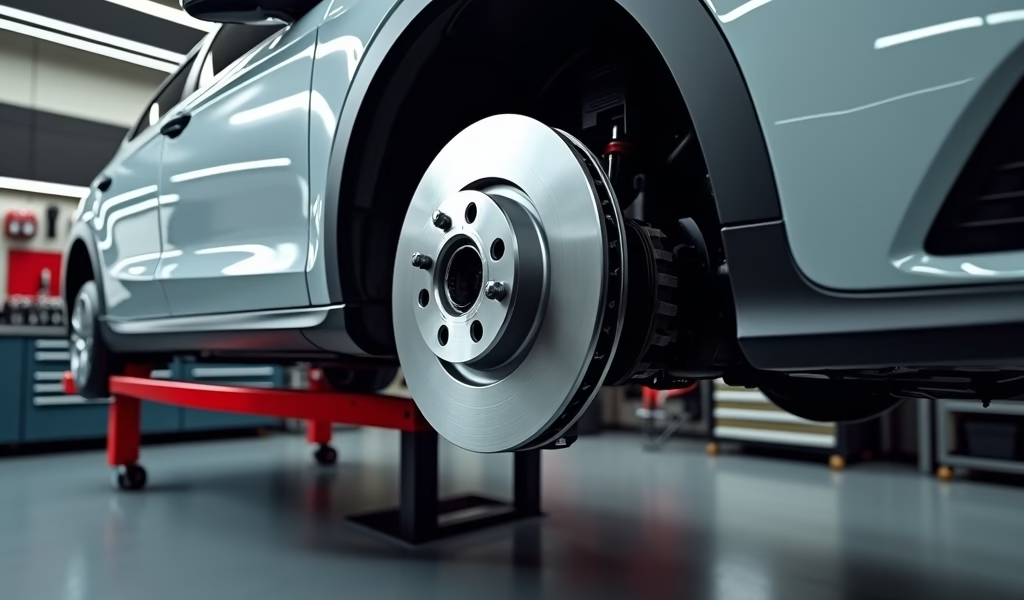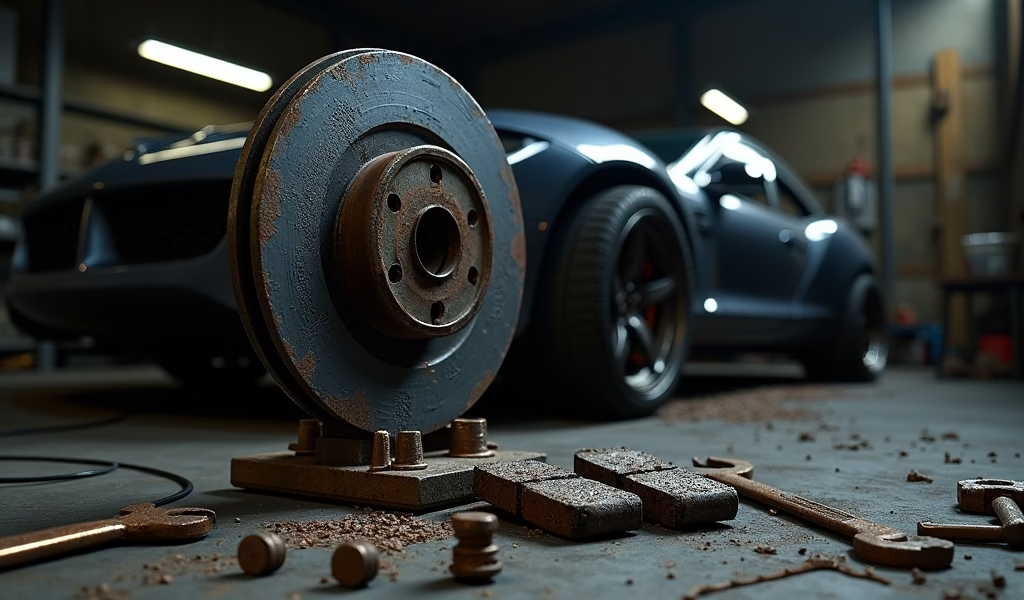Overview
This article provides a detailed breakdown of brake pad and rotor replacement costs ($300-$800 for all four wheels), explaining the factors that influence pricing including vehicle type, component quality, and labor rates. It offers practical money-saving strategies like comparing quotes and proper maintenance tips to extend brake life, while emphasizing that brakes are a critical safety system where quality should never be compromised.
Table of Contents
- Understanding Brake Components: What You’re Paying For
- Average Cost Breakdown for Brake Pads and Rotors
- DIY vs. Professional Replacement: Costs Compared
- Factors That Affect Your Brake Replacement Costs
- Signs Your Brake Pads and Rotors Need Replacement
- Pro Tips for Saving Money on Brake Services
- Maintenance Tips to Extend Brake Life
- Conclusion: Making Smart Decisions About Brake Repairs
- Frequently Asked Questions
Understanding Brake Components: What You’re Paying For
When it comes to brake pads and rotors cost, understanding what you’re actually paying for makes all the difference. As a mechanic who’s replaced thousands of braking systems, I can tell you that knowledge is your best defense against overpaying.
Brake pads are the friction material that presses against your rotors (also called discs) to slow your vehicle. Think of them as the workhorses of your braking system. Made typically of ceramic, semi-metallic, or organic materials, these components wear down naturally with use.
Rotors, meanwhile, are the smooth metal discs that your brake pads grip. They absorb and dissipate the tremendous heat generated during braking. A Toyota Camry’s rotors, for example, can reach temperatures of 300-400°F during normal driving and much higher during hard braking.
Together, these components form the heart of your disc brake system. When you press your brake pedal, hydraulic pressure forces the brake pads against the spinning rotors, creating friction that slows your wheels. Simple in concept, but crucial for your safety.
The quality of these components directly impacts both performance and longevity. Premium ceramic pads might cost more initially but often provide quieter braking and less dust than budget alternatives. Similarly, high-carbon rotors dissipate heat more effectively than basic ones, potentially extending their lifespan by thousands of miles.
Understanding these basics helps contextualize the costs associated with brake replacement and makes you better equipped to evaluate quotes from your mechanic.
Average Cost Breakdown for Brake Pads and Rotors
Let’s talk dollars and cents. The typical brake pads and rotors cost for a complete replacement (all four wheels) ranges from $300 to $800+ depending on your vehicle. But this broad range demands some unpacking.
For parts alone, expect to pay:
- Brake pads: $30-$100 per axle (budget to premium)
- Rotors: $30-$200+ each (basic to high-performance)
Labor typically adds $150-$300 for a complete service. A Honda Civic owner might pay around $450 total for mid-grade components on all four wheels, while a BMW 5-Series owner could easily spend $800+ for the same service due to higher-priced parts and more complex labor.
Dealerships generally charge 20-30% more than independent shops. For example, a Toyota dealership might charge $600 for a complete brake job that would cost $450 at your trusted local mechanic’s garage.
Geographic location matters too. Urban areas like New York or San Francisco typically command higher labor rates than rural locations. The same brake job might cost $700 in Manhattan but $500 in a small Midwestern town.
Remember that skimping on quality rarely pays off. I’ve seen countless customers return after choosing the bargain option, only to need replacement again in half the expected time. According to Consumer Reports’ brake maintenance studies, premium pads typically last 30,000-70,000 miles versus 30,000-40,000 for budget options.
If you’re only replacing pads without turning or replacing rotors (not always recommended), costs drop significantly to $100-$300 total. However, this approach can lead to uneven wear, noise, and reduced braking performance if your rotors are already compromised.

DIY vs. Professional Replacement: Costs Compared
Wondering if you should tackle brake replacement yourself? Let’s compare the financial angles of DIY versus professional service.
A DIY brake job can save you $150-$300 in labor costs. For a typical mid-size sedan like a Nissan Altima, you might spend about $250 on quality parts versus $500-$600 for a professional job. That’s potentially cutting your costs in half!
But before you rush to grab your socket set, consider what you’ll need:
- Jack and jack stands (or ramps): $50-$200 if you don’t already own them
- Socket set and specialized tools: $30-$100
- Brake fluid: $5-$15
- Brake cleaner: $5-$10
- Anti-seize lubricant: $5-$10
First-timers should also factor in the time investment—what might take a professional 1-2 hours could easily consume your entire Saturday. I recently helped a neighbor with his first DIY brake job on a Ford F-150, and what should have been a 2-hour project stretched to 6 hours with multiple trips to the auto parts store.
There’s also the expertise factor. Professional mechanics have specialized tools, lift equipment, and the experience to spot potential issues you might miss. For instance, a failing caliper might not be obvious to an untrained eye but could compromise your newly installed pads if left unaddressed.
The sweet spot? Many DIYers replace their own pads but leave rotor replacement to professionals. This hybrid approach can still save you $100-$150 while avoiding some of the more technical challenges.
If you’re mechanically inclined and have the proper tools, DIY brake replacement is absolutely doable. The step-by-step guides from Popular Mechanics provide excellent reference for first-timers. Just know what you’re getting into—and have a professional’s number handy just in case.
Factors That Affect Your Brake Replacement Costs
Several key factors influence how much you’ll pay for brake work. Understanding these variables helps you make informed decisions and potentially reduce your overall brake pads and rotors cost.
Vehicle type and size significantly impact price. Economy cars like a Honda Fit use smaller, less expensive components than a Ford F-250 truck. The price difference can be dramatic—compact car owners might pay $400 for a complete brake job while truck owners could face bills approaching $1,000.
Performance and luxury vehicles demand premium components. A Porsche Cayenne, for instance, requires specialized high-temperature pads and larger rotors that can cost three times what you’d pay for a Toyota RAV4. These vehicles often have more complex braking systems that require additional labor time.
Component quality creates substantial price variations. Economy ceramic pads might cost $30 per axle, while premium ceramic options with better heat dissipation and longer warranties might run $80-$100. Similarly, basic rotors might cost $40 each, while drilled and slotted performance rotors for better cooling could exceed $150 each.
Additional repairs often arise during brake service. When I inspect brakes, I frequently find issues like:
- Seized calipers: $100-$300 each to replace
- Deteriorated brake hoses: $40-$150 to replace
- Master cylinder problems: $150-$500 to address
These aren’t upsells—they’re legitimate safety concerns. A caliper that’s not fully retracting, for example, will quickly destroy your new pads through excess heat and friction.
Finally, regional differences in labor rates can vary by as much as 30-40%. The national average for brake labor is about $80-$120 per hour, but rates exceed $150 in some metropolitan areas.
By understanding these variables, you can better evaluate quotes and ask informed questions. For instance, knowing that premium rotors cost more but last longer might influence your decision when comparing estimates between shops.
Signs Your Brake Pads and Rotors Need Replacement
Recognizing when your brakes need attention saves you money and prevents more expensive damage. As someone who’s diagnosed countless brake issues, I’ll share the telltale signs that shouldn’t be ignored.
That high-pitched squealing when you brake isn’t just annoying—it’s a deliberate warning. Most brake pads include wear indicators specifically designed to create this noise when pad material reaches minimum safe thickness (typically 3-4mm). Think of it as your car’s way of saying “feed me new pads before things get expensive!”
A pulsating brake pedal often indicates warped rotors. This happens when rotors develop thickness variations from excessive heat. I recently worked on a Subaru Outback whose owner described the steering wheel “shuddering during braking”—classic symptoms of warped front rotors that required replacement.
Decreased braking performance is subtle but serious. If your stopping distance has increased or the pedal feels softer, your brakes are crying for help. One customer came in complaining about needing to “press harder than normal” on her Honda Accord’s brake pedal—we discovered pads worn down to the metal backing.
Visual inspection provides clear evidence. Through your wheel spokes, you might see a thin brake pad (less than ¼ inch) or deep grooves and scoring on the rotor surface. These visible signs indicate immediate replacement is needed.
Grinding noises mean you’ve waited too long. This metal-on-metal sound indicates your pad material is completely gone, and the backing plate is digging into your rotor. At this stage, you’re not just replacing pads—you’re definitely replacing damaged rotors too, substantially increasing your brake pad and rotor replacement costs.
Addressing these symptoms promptly typically saves hundreds in repair costs. For example, replacing just pads at the first sign of squealing might cost $150-$200, while waiting until rotors are damaged could push your bill to $400-$600.

Pro Tips for Saving Money on Brake Services
After 20+ years working on brakes, I’ve developed strategies to help customers minimize costs without compromising safety. These insider tips can potentially save you hundreds on your next brake service.
Get multiple quotes, but be specific about components. When I call shops for family members, I request quotes for “premium ceramic pads and standard rotors for all four wheels” to ensure I’m comparing apples to apples. Price differences for identical services often range from 20-30% between shops.
Consider timing your brake service. Many shops offer seasonal specials—typically during slower periods in late winter or mid-summer. Taking advantage of these promotions can save 10-15% off regular pricing.
Ask about rotor refinishing rather than replacement. If your rotors meet minimum thickness specifications but have minor surface issues, machine resurfacing (often called “turning”) can restore them for $15-$25 per rotor versus $40-$150+ for replacement. This approach saved a recent customer over $200 on his Chevy Malibu brake service.
Supply your own parts with caution. Some independent shops will install customer-provided parts, potentially saving you 15-30% on component costs. However, be aware that you typically won’t get a parts warranty, and not all shops offer this option.
Negotiate package deals. If you need both front and rear brakes, ask for a package discount. Many shops will reduce the total by 5-10% for complete jobs versus doing them separately. Similarly, combining brake work with other maintenance often results in labor savings.
Consider mid-grade components for older vehicles. If you’re driving an older car with less than 50,000 miles of expected future use, premium components might be overkill. As a mechanic, I often recommend mid-grade parts for these situations, saving customers $50-$100 without significantly impacting performance.
Maintain your membership benefits. Organizations like AAA, AARP, and even some credit card companies offer member discounts at participating repair facilities—typically 5-10% off services. These discounts are frequently overlooked by customers.
By combining several of these strategies, you can potentially reduce your total brake replacement expenses by 20-30% without cutting corners on quality or safety.
Maintenance Tips to Extend Brake Life
Preventive care dramatically extends the life of your braking system. These professional recommendations help you get maximum mileage from your investment and postpone your next brake pads and rotors cost.
Adjust your driving habits. Aggressive driving is the number one killer of brake components. Maintaining proper following distance and anticipating stops allows you to brake gradually rather than suddenly. I’ve seen identical vehicles where one owner gets 70,000 miles from their brakes while the “lead-foot” twin needs replacement at 30,000 miles.
Reduce brake-killing behaviors like these:
- Riding the brakes downhill (use lower gears instead)
- “Two-foot driving” (resting your left foot on the brake pedal)
- Carrying unnecessary weight (extra 100lbs reduces brake life by 5-7%)
Regular brake fluid flushes extend component life. Fresh fluid prevents corrosion within the hydraulic system and maintains proper braking pressure. Most manufacturers recommend replacing brake fluid every 2-3 years, yet many vehicles go 5+ years without this $70-$120 service.
Periodically clean your braking system if you live in areas with road salt or heavy dust. A simple spray with brake cleaner during tire rotations helps prevent caliper binding and pad glazing. This five-minute maintenance can add thousands of miles to brake life.
Address unusual sounds immediately. That minor squeak can quickly become a major repair if ignored. I recently saved a customer $300 by lubricating caliper slide pins that were causing uneven pad wear before the pads were damaged beyond salvage.
Follow manufacturer-recommended tire rotation schedules. Even tire wear contributes to even brake wear, as unbalanced tires create uneven brake pressure distribution. The typical 5,000-7,000 mile rotation interval optimizes both tire and brake longevity.
Consider brake system inspections during regular oil changes. Many shops offer free brake checks, and these quick evaluations can catch minor issues before they become major expenses. This proactive approach typically extends component life by 15-20%.
Conclusion: Making Smart Decisions About Brake Repairs
Understanding brake pads and rotors cost empowers you to make informed decisions that balance safety, performance, and budget. As we’ve explored, prices vary significantly based on vehicle type, component quality, and where you get the work done.
Remember that brakes are perhaps the most critical safety system in your vehicle. While saving money is important, cutting corners on brake work is never worth the risk. Quality parts, proper installation, and preventive maintenance deliver the best long-term value.
The average complete brake job costs between $300-$800, but with the strategies outlined in this guide, you can potentially save 20-30% without compromising quality. Whether you choose DIY installation, negotiate better pricing, or simply maintain your existing components more effectively, you now have the knowledge to make smart brake repair decisions.
By recognizing warning signs early, you can often address brake issues before they escalate into more costly repairs. That squealing noise or slight pulsation deserves prompt attention—your wallet and your safety both benefit from proactive brake care.
Apply these professional insights to become a more informed consumer when it comes to brake services. Your vehicle, your safety, and your budget will thank you.
Frequently Asked Questions
How often should brake pads and rotors be replaced?
Brake pads typically need replacement every 30,000-70,000 miles depending on driving habits and pad quality. Rotors generally last through 2-3 pad replacements (60,000-150,000 miles) unless damaged by worn-out pads.
Is it necessary to replace rotors with pads?
Not always, but it’s increasingly common as rotors have become thinner in modern vehicles. If rotors show significant grooving, heat damage, or are below minimum thickness specifications, replacement is necessary.
What’s the difference between cheap and expensive brake pads?
Premium pads typically offer better heat dissipation, less noise, reduced brake dust, and longer life expectancy. The quality of friction materials, backing plates, and noise reduction features justifies the higher price through improved performance and longevity.
Can I replace just the front or rear brakes?
Yes, brake pads and rotors are typically replaced axle by axle, not as a complete set. Front brakes generally wear 2-3 times faster than rear brakes in most vehicles due to weight transfer during braking.
How can I tell if I need new rotors or just pads?
Rotors need replacement if they have deep grooves, significant rust, heat spots, or thickness below specifications. A pulsating brake pedal typically indicates warped rotors that require replacement rather than just new pads.

